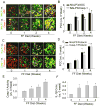Activation of Nod-like receptor protein 3 inflammasomes turns on podocyte injury and glomerular sclerosis in hyperhomocysteinemia
- PMID: 22647887
- PMCID: PMC3753400
- DOI: 10.1161/HYPERTENSIONAHA.111.189688
Activation of Nod-like receptor protein 3 inflammasomes turns on podocyte injury and glomerular sclerosis in hyperhomocysteinemia
Abstract
Inflammasome is a multiprotein complex consisting of Nod-like receptor protein 3 (NALP3), apoptosis-associated speck-like protein (ASC), and caspase 1 or 5, which functions to switch on the inflammatory process. The present study hypothesized that the formation and activation of NALP3 inflammasomes turn on podocyte injury leading to glomerulosclerosis during hyperhomocysteinemia (hHcys). RT-PCR and Western blot analysis demonstrated that murine podocytes expressed 3 essential components of the NALP3 inflammasome complex, namely, NALP3, ASC, and caspase 1. Treatment of podocytes with l-homocysteine induced the formation of NALP3 inflammasome complex, an increase in caspase 1 activity, podocyte cytoskeleton rearrangement, and decreased production of vascular endothelial growth factor from podocytes, which were all blocked by silencing the ASC gene or inhibiting caspase 1 activity. In mice with hHcys induced by feeding them a folate-free diet, NALP3 inflammasome formation and activation in glomerular podocytes were detected at an early stage, as shown by confocal microscopy, size exclusion chromatography of the assembled inflammasome complex, and increased interleukin-1β production in glomeruli. Locally silencing the ASC gene in the kidney significantly reduced NALP3 inflammasome formation and interleukin 1β production in glomeruli of mice with hHcys. Pathologically, hHcys-associated albuminuria, foot process effacement of podocytes, loss of podocyte slit diaphragm molecules, and glomerulosclerosis at the late stage were significantly improved by local ASC gene silencing or by caspase 1 inhibition. In conclusion, NALP3 inflammasome formation and activation on stimulation of homocysteine are important molecular mechanisms triggering podocyte injury and ultimately resulting in glomerulosclerosis in hHcys.
Figures





References
-
- Mariathasan S, Newton K, Monack DM, Vucic D, French DM, Lee WP, Roose-Girma M, Erickson S, Dixit VM. Differential activation of the inflammasome by caspase-1 adaptors asc and ipaf. Nature. 2004;430:213–218. - PubMed
-
- Zhou R, Tardivel A, Thorens B, Choi I, Tschopp J. Thioredoxin-interacting protein links oxidative stress to inflammasome activation. Nat Immunol. 2010;11:136–140. - PubMed
-
- Niemir ZI, Stein H, Dworacki G, Mundel P, Koehl N, Koch B, Autschbach F, Andrassy K, Ritz E, Waldherr R, Otto HF. Podocytes are the major source of il-1 alpha and il-1 beta in human glomerulonephritides. Kidney Int. 1997;52:393–403. - PubMed
Publication types
MeSH terms
Substances
Grants and funding
LinkOut - more resources
Full Text Sources
Molecular Biology Databases
Miscellaneous

